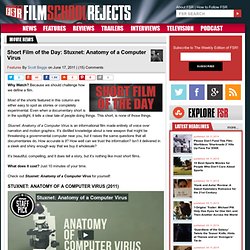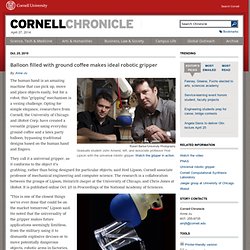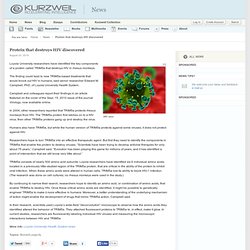

Scottish Scientists Are Trying to Create Inorganic Life. Scientists at Glasgow University are on a mission to create a form of life from inorganic molecules.

The team, led by Professor Lee Cronin, has demonstrated a way of creating an inorganic cell, in which internal membranes control the movement of energy and materials, just as in a living cell. These cells can also store electricity and could be used in medicine and chemistry as sensors or to contain chemical reactions. This research is part of Cronin's larger project to show that inorganic compounds are able to self-replicate and evolve like biological cells do. The ultimate goal is to give these inorganic cells life-like properties so they can evolve and eventually be used in materials science. Cronin said he believes creating inorganic life is entirely possible, that if biological organisms evolved from single-cell bacteria, so should life be able to evolve from inorganic microorganisms.
Short Film of the Day: Stuxnet: Anatomy of a Computer Virus. Why Watch?

Because we should challenge how we define a film. Most of the shorts featured in this column are either easy to spot as stories or completely experimental.
Teleportation and forcefields possible within decades, says Professor Michio Kaku. 4 Rare Earth Elements That Will Only Get More Important. Boy discovers microbe that eats plastic. It's not your average science fair when the 16-year-old winner manages to solve a global waste crisis. But such was the case at last May's Canada-Wide Science Fair in Ottawa, Ontario, where Daniel Burd, a high school student at Waterloo Collegiate Institute, presented his research on microorganisms that can rapidly biodegrade plastic. It’s In the Bag! Teenager Wins Science Fair, Solves Massive Environmental Problem. Universal robotic gripper. Robert Barker/University Photography The human hand is an amazing machine that can pick up, move and place objects easily, but for a robot, this "gripping" mechanism is a vexing challenge.

Opting for simple elegance, researchers from Cornell, the University of Chicago and iRobot Corp. have created a versatile gripper using everyday ground coffee and a latex party balloon, bypassing traditional designs based on the human hand and fingers. They call it a universal gripper, as it conforms to the object it's grabbing, rather than being designed for particular objects, said Hod Lipson, Cornell associate professor of mechanical engineering and computer science. The research is a collaboration between the groups of Lipson, Heinrich Jaeger at the University of Chicago, and Chris Jones at iRobot. It is published online Oct. 25 in Proceedings of the National Academy of Sciences.
John Amend. The Turing Test. First published Wed Apr 9, 2003; substantive revision Wed Jan 26, 2011 The phrase “The Turing Test” is most properly used to refer to a proposal made by Turing (1950) as a way of dealing with the question whether machines can think.

According to Turing, the question whether machines can think is itself “too meaningless” to deserve discussion (442). Email Overload Fix: 3 Sentence Emails. Email is taking up too much time in our lives.

Do yourself and your recipients a favor by making your emails 3 sentences or less. If we all do it, imagine the time we’ll have to do other things. The Next Steps In Robotics And Computer Vision: Behavior Analysis, Situational Awareness. We’ve seen some interesting developments lately in the fields of robotics and computer vision.

They’re not as academic as you’d expect: enormous tech successes like the Roomba and Kinect have relied as much on clever algorithms and software development as they have on marketing and retail placement. Accelerating Future » 10 Interesting Futuristic Materials. For One Tiny Instant, Physicists May Have Broken a Law of Nature. This image of a full-energy collision between gold ions shows the paths taken by thousands of subatomic particles produced during the impact.

For a brief instant, it appears, scientists at Brookhaven National Laboratory on Long Island recently discovered a law of nature had been broken. Action still resulted in an equal and opposite reaction, gravity kept the Earth circling the Sun, and conservation of energy remained intact. But for the tiniest fraction of a second at the Relativistic Heavy Ion Collider (RHIC), physicists created a symmetry-breaking bubble of space where parity no longer existed. Parity was long thought to be a fundamental law of nature. It essentially states that the universe is neither right- nor left-handed — that the laws of physics remain unchanged when expressed in inverted coordinates. Now this law appears to have been broken by a team of about a dozen particle physicists, including Jack Sandweiss, Yale's Donner Professor of Physics.
Protein that destroys HIV discovered. Loyola University researchers have identified the key components of a protein called TRIM5a that destroys HIV in rhesus monkeys.

The finding could lead to new TRIM5a-based treatments that would knock out HIV in humans, said senior researcher Edward M. Campbell, PhD, of Loyola University Health System. Campbell and colleagues report their findings in an article featured on the cover of the Sept. 15, 2010 issue of the journal Virology, now available online. In 2004, other researchers reported that TRIM5a protects rhesus monkeys from HIV.
Energy Biosciences Institute.